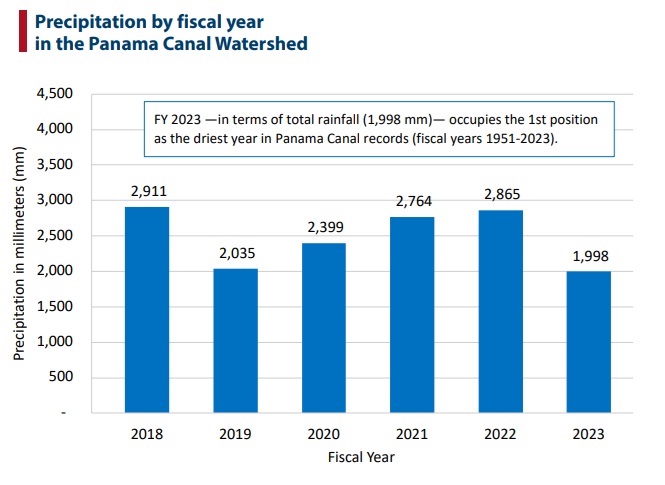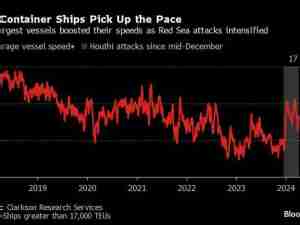Now nearing the end of the dry season, the Panama Canal is adapting to the climate conditions. Based on the present and projected water level of Gatun Lake, and due to the Operational Water Strategy (OWS) that the Panama Canal has implemented, additional slots announced earlier this month are now available as of March 25, bringing the total transits offered up to 27 per day. Recent precipitation and progress secured by the Canal’s ongoing water-saving efforts are turning the tide.
Nonetheless, misperceptions continue to linger about the impacts of the recent drought on the Canal operations and global trade. To alleviate concerns, please see a breakdown below of common misconceptions with clarifying information below to help shed light on the waterway's evolving operations.

MYTH: There is a long queue of ships waiting to transit outside of the Panama Canal, causing a bottleneck.
• TRUTH: The number of vessels outside the Panama Canal (approximately 50) is on par with the amount expected under the current conditions with 27 slots available daily.
• The majority of vessels have reservations and routinely arrive early ahead of their allotted date to transit the Canal. It is common for these vessels to refuel or replenish supplies before they begin their scheduled passage.
MYTH: There is no end in sight for the drought-driven transit restrictions at the Panama Canal.
• TRUTH: Current forecasts indicate that steady rainfall will arrive in late April and continue for a few months. If this remains the case, the Canal plans to gradually ease transit restrictions, allowing conditions to fully normalize by 2025.
• All modifications to restrictions will be contingent on the forecasts. If rains are short of expectations, the Canal could retain or apply further restrictions to either daily passage or draft. However, moderate precipitation is expected to arrive later this month and grow in intensity, which would allow the Canal to progressively increase daily slots back to the 36 daily transits typically offered during the rainy season.
• The Canal will continue to closely monitor rainfall patterns and announce any updates as soon as possible.
MYTH: Ships are waiting for long periods before they can transit the waterway.
• TRUTH: More than three-quarters of vessels outside the Panama Canal today have reservations and therefore will transit the Panama Canal on a predetermined date with minimal to no waiting time.
• The average waiting time for vessels arriving without reservations this year has been just under 2.5 days, far lower than the 3.6 days experienced between January and March last year, and the 3.8 days recorded during the same period in 2022.
MYTH: The drought and transit restrictions have caused unreliability and a growing bottleneck at the Panama Canal.
• TRUTH: Transits remain reliable so long as they are booked in advance, so the Canal urges its customers to make reservations ahead of time.
• Even despite the conditions, the Panama Canal has been able to facilitate a daily average of 27 transits so far this year. This has allowed for a steady flow of vessels rather than a growing backlog.
• The waterway continues to proudly serve over 180 maritime routes, connecting 170 countries and reaching approximately 1,920 ports worldwide.
MYTH: The cost of transiting the Panama Canal is significantly more expensive than normal.
• TRUTH: Last year, mainly during the months October and November, there was a surge in auction prices related to a market-driven congestion premium, though this is no longer the case.
• Since the peak period last year, auction prices have leveled off. They are generally near normal levels today, though auctions remain an invaluable tool and option for customers who may otherwise not have secured reservations.
• Auction prices are also not set by the waterway, but rather influenced by many factors and market dynamics. Other factors include internal considerations such as waiting times and queue lengths, as well as external elements like charter rates and bunker prices. Additionally, the specific preferences and needs of individual customers, which may not be fully captured by the route value model, can also influence auction outcomes.
MYTH: Competing alternative routes may start to impact the use of the Panama Canal route.
• TRUTH: While we are always monitoring potential projects that could compete with our route, we remain confident in our service and are making investments to ensure we remain the most efficient, reliable, and trusted partner for global trade.
• The competitiveness of the Canal has been tested by various events over the years, from fleet overcapacity to decreases in the demand of commodities and low fuel prices to trade conflicts and more. We have successfully overcome these challenges over the past 100+ years by remaining adaptable in this very dynamic environment, which continues to be our approach.
MYTH: The quality of water is less important than the quantity of water conserved by the Panama Canal.
• TRUTH: This is simply not true. The Panama Canal has a constitutional mandate to manage lake water quality and quantity, with water for human consumption a top priority. Maintaining salinity levels within reference values and preventing any associated risks is part of that responsibility so the quality of water in Gatun lake is regularly monitored.
• The process is aimed at ensuring that the raw water destined for the potabilization process meets the strict standards established by Panamanian drinking water regulations.
• To further help with this effort, the Panama Canal just inaugurated a cutting-edge Water Quality Laboratory, a unique facility in the region, this month. Equipped with state-of-the-art technology, the lab will allow for even more diligent monitoring and protection of the water supply as other water-saving solutions are implemented.
MYTH: Panama is one of the world’s wettest countries. With frequent rain, the Panama Canal should have plenty of water.
• TRUTH: While Panama may receive precipitation, rainfall has not occurred as consistently within the Panama Canal Watershed due to changes in weather patterns, exacerbated by the impacts of climate change.
• Last year marked the area’s third driest year since the country began keeping records over 140 years ago.

MYTH: Solutions for strengthening water management at the Panama Canal are unclear.
• TRUTH: While no simple answer or single project will immediately solve the challenge of water, the Canal is advancing a series of short-term and long-term solutions.
• The implementation of a more robust water management system has become a critical priority in recent years and a series of potential solutions have been studied, looking first at options within the Canal’s jurisdiction. However, the waterway’s specialists—in conjunction with US Army Corps of Engineers (USACE)—have confirmed that technical solutions within the Panama Canal’s jurisdiction are not sufficient to meet the growing demand for water. Instead, a set of solutions will need to be pursued, some of which fall outside of the Panama Canal Watershed.
• Advancing any solutions outside the Canal Watershed requires approval from the Panamanian government. Therefore, the Canal’s Board of Directors, as part of its mandate, delivered a proposal to the government to advance this process in September 2023. The proposal focuses on two key asks, the first of which is to define the Canal Watershed and modify or expand the limits established in Law 20 of 2006. The second ask is to eliminate the restrictions imposed on the Canal in Law 28 of 2006 for the construction of a new reservoir. The Panama Canal is ready to advance the process and develop long-term solutions as soon as possible.
• In the meantime, the Canal is using water-saving measures to conserve supplies during its operations. These efforts, together with recent precipitation, have led to improvements in water levels and increases in daily transits. Additional shorter-term solutions to help optimize the use and storage of water are also in progress. One such project already being advanced will improve the use and reliability of water stored at Gatun Lake.




_-_28de80_-_939128c573a41e7660e286f3686f2a6e25686350_yes.jpg)





